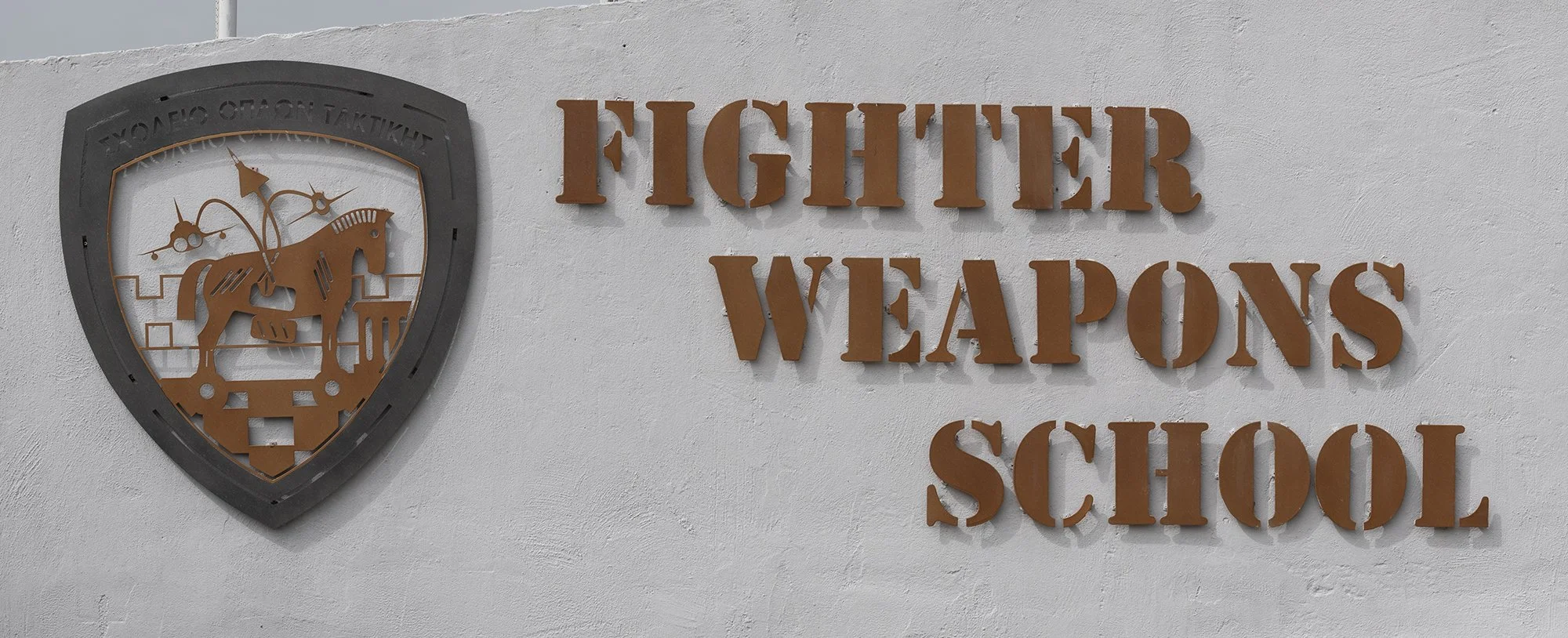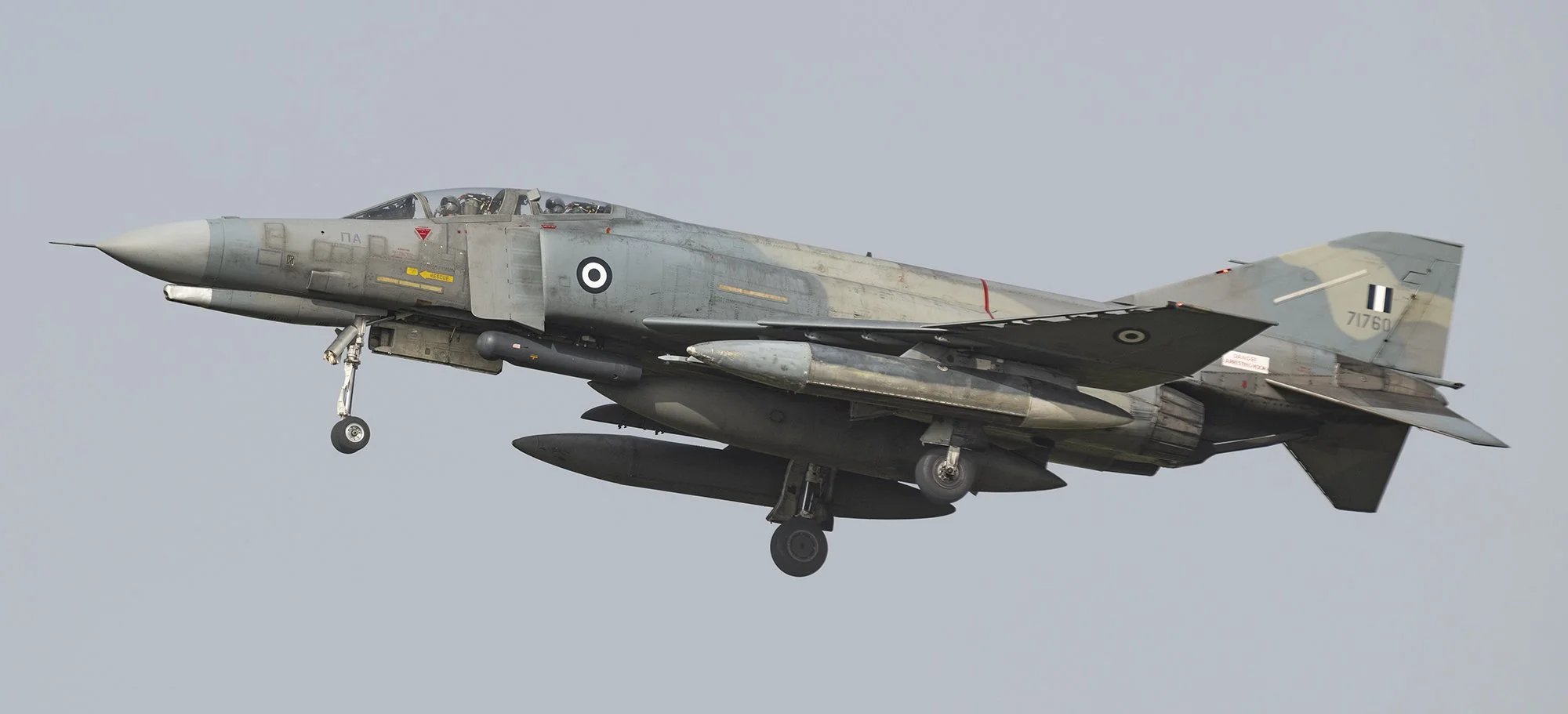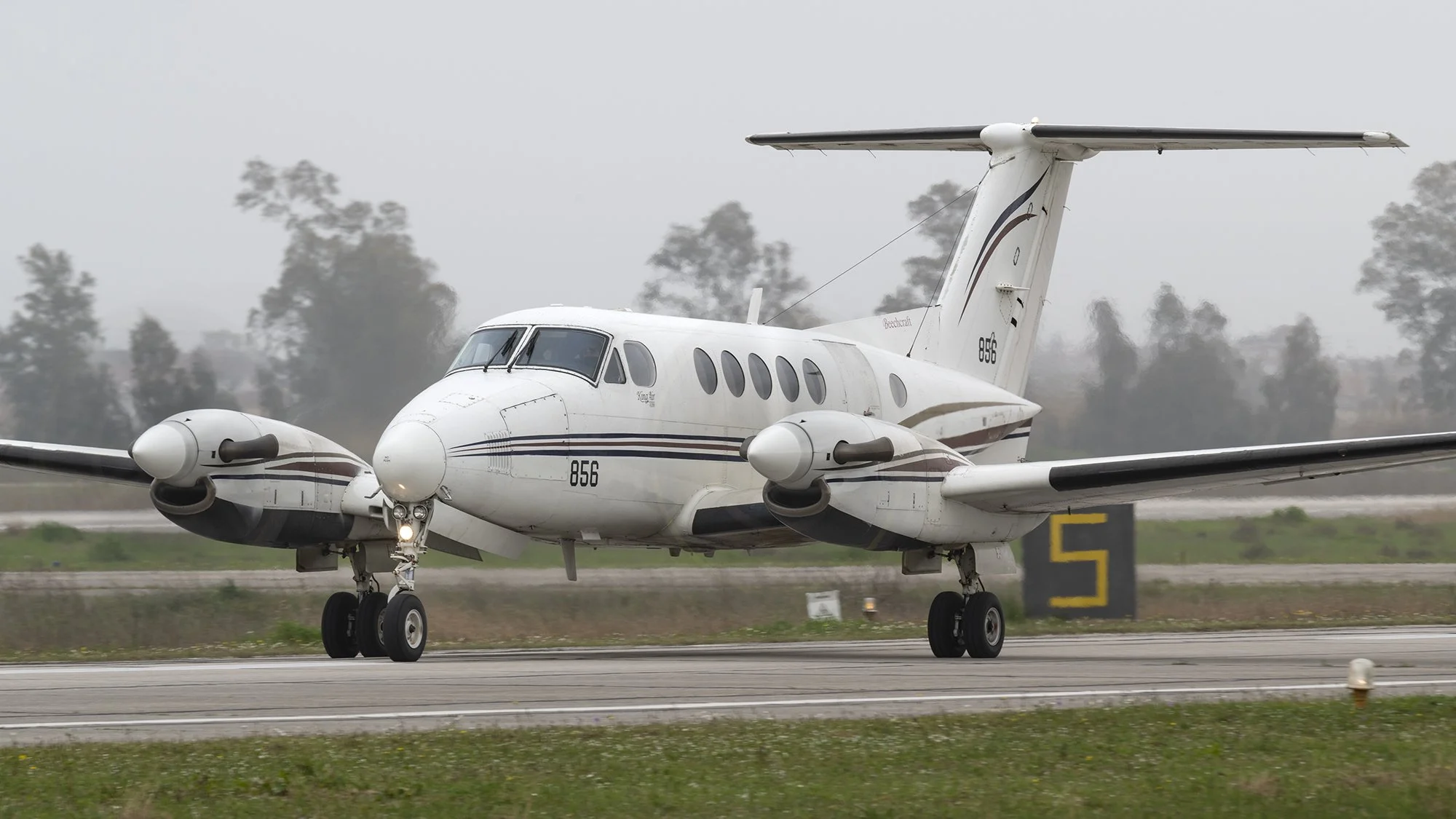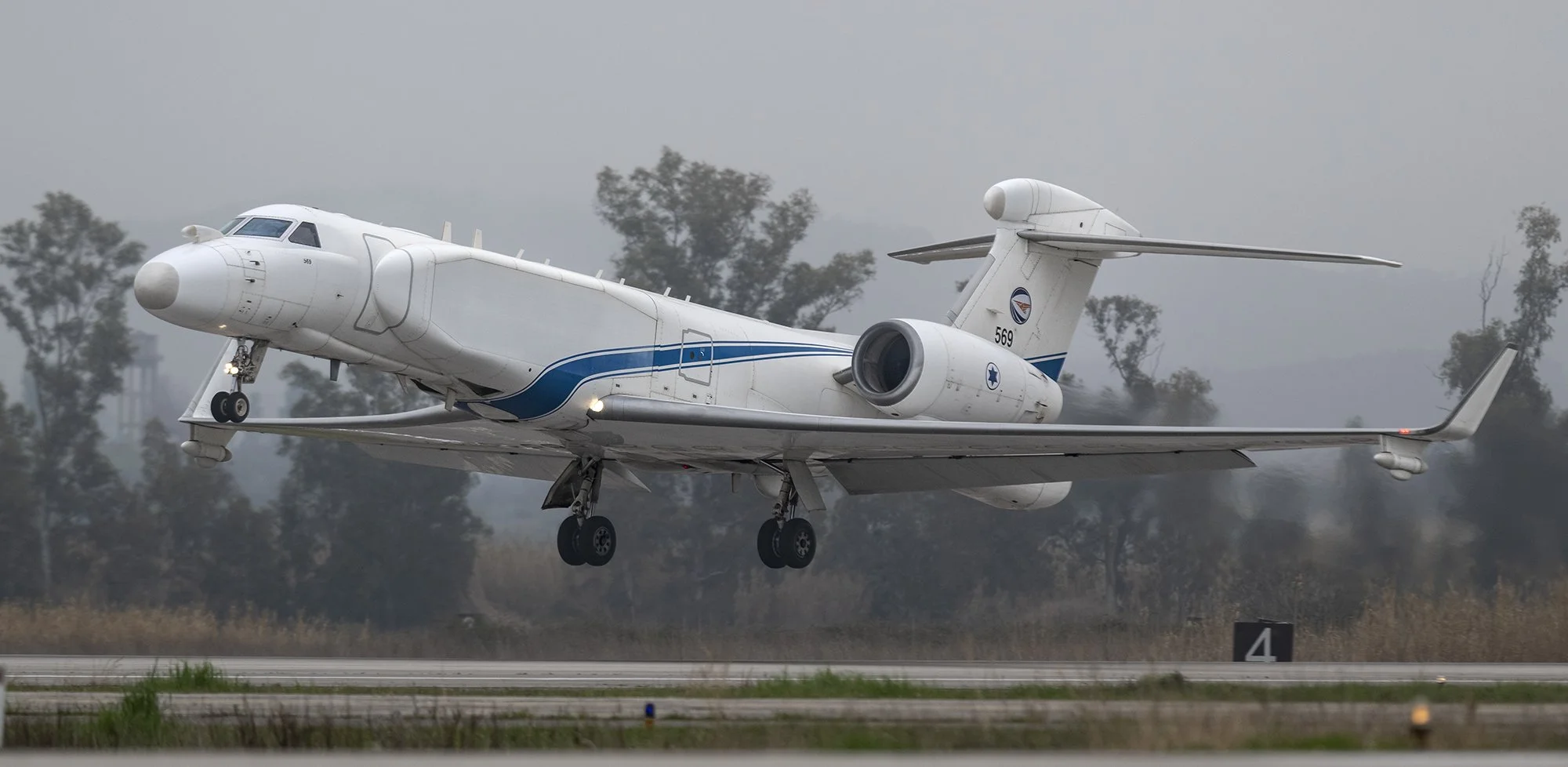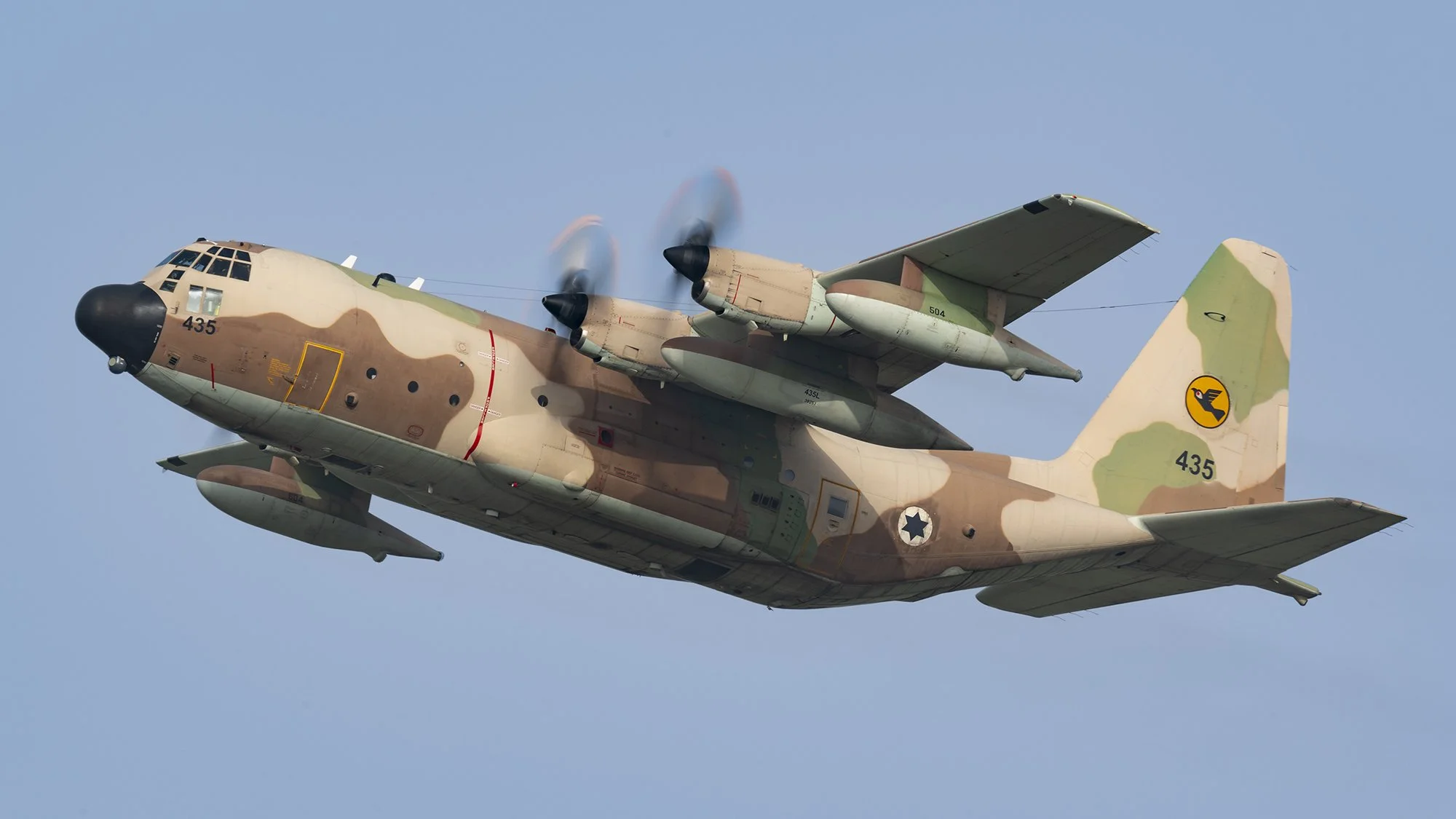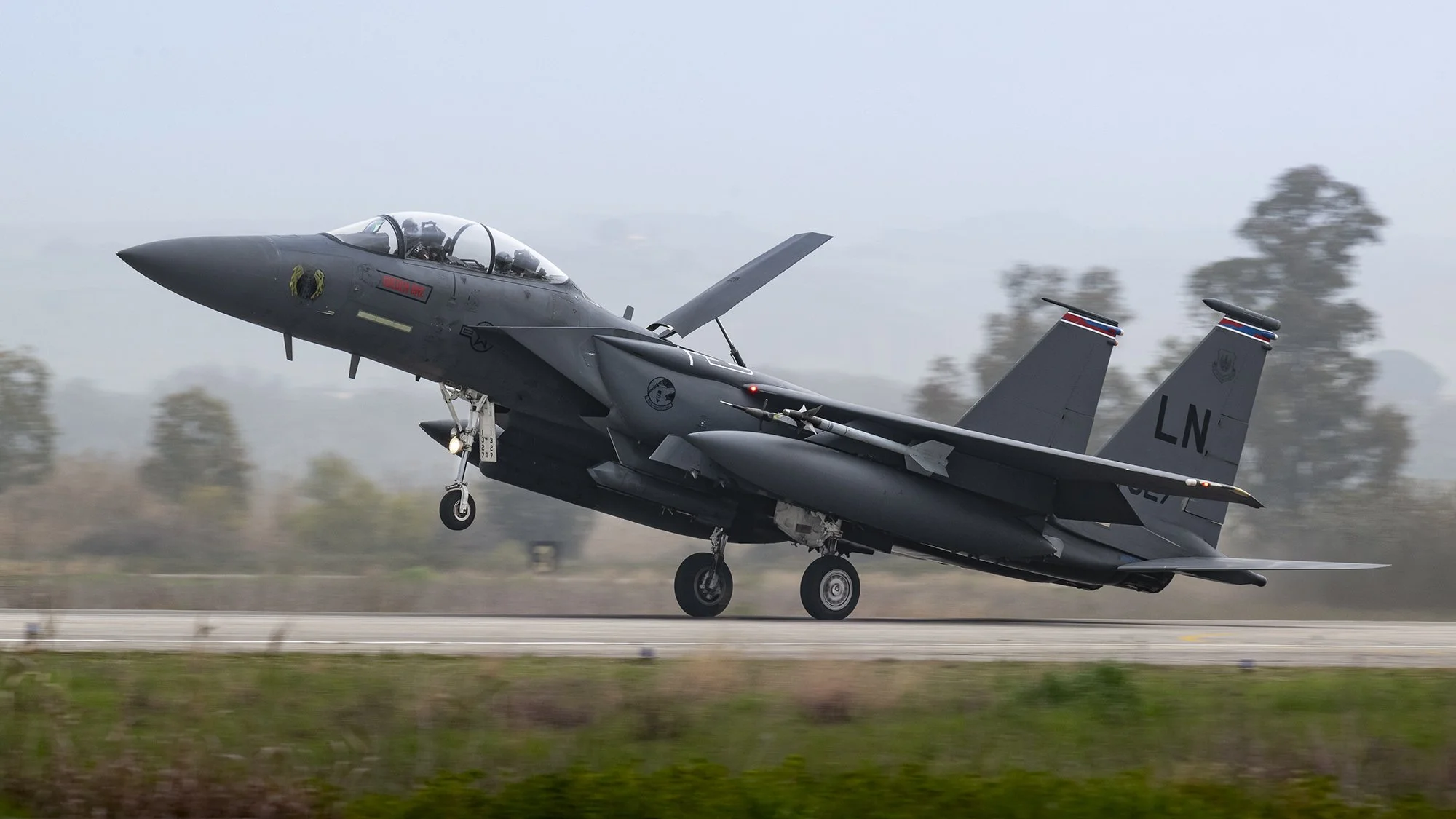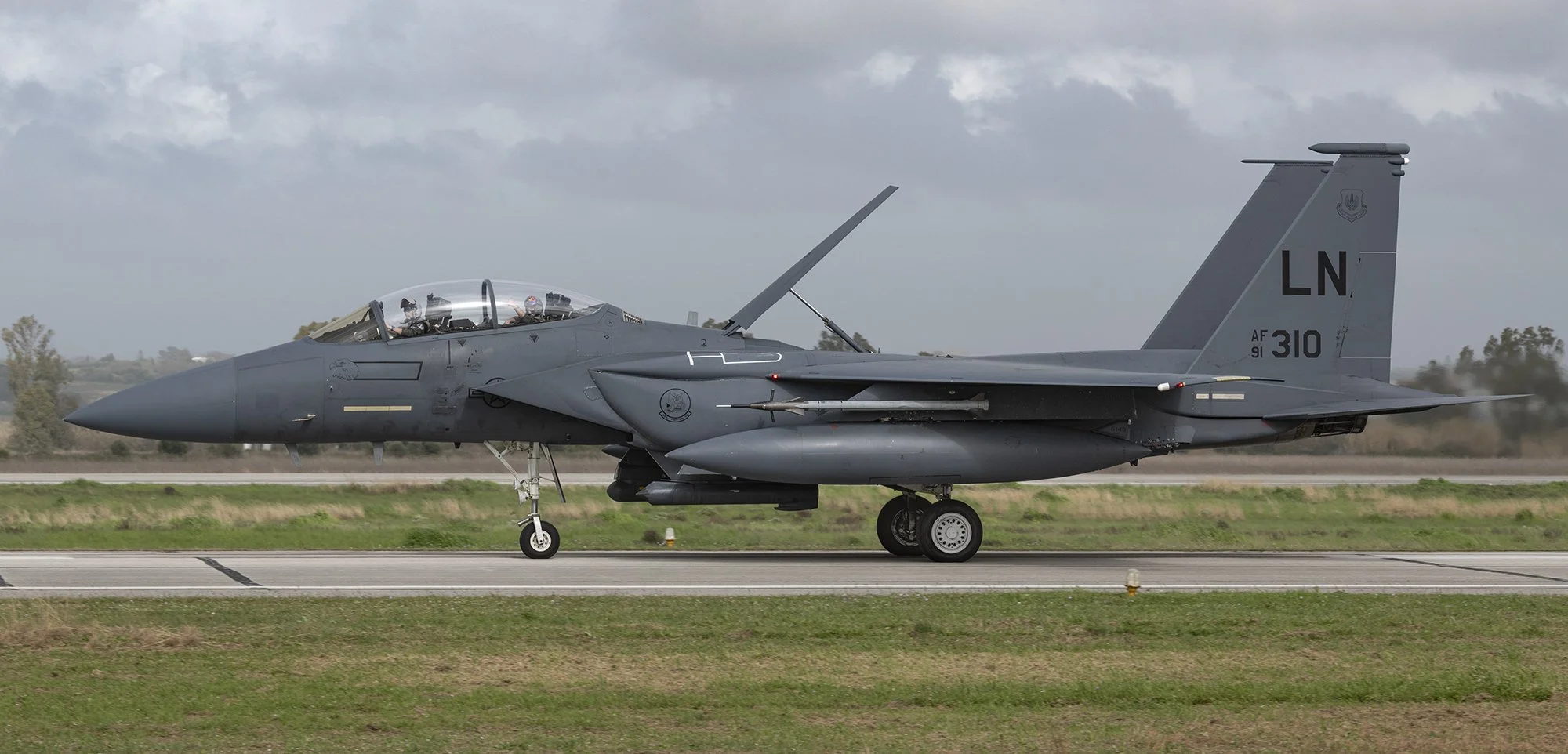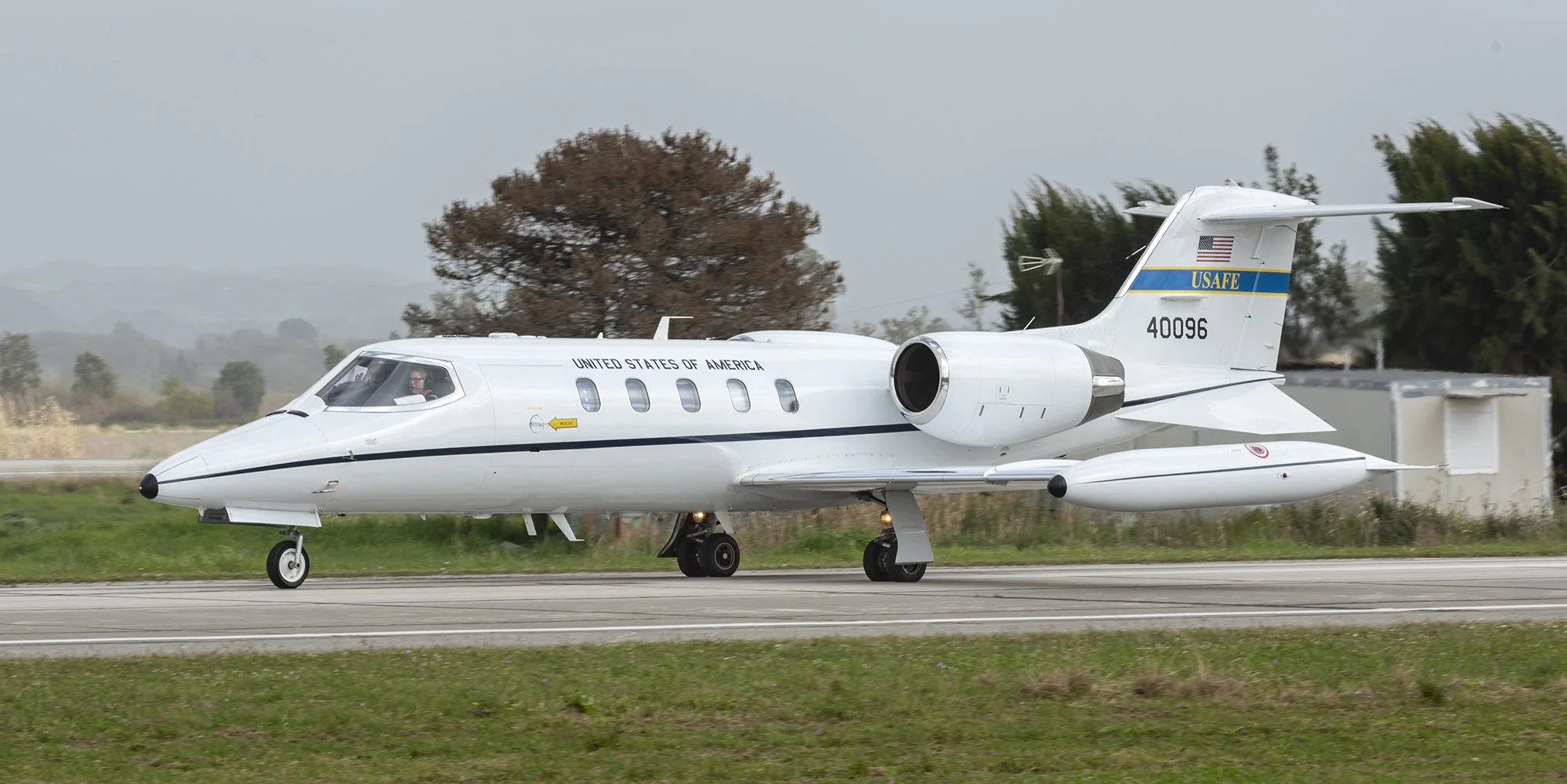CHARIOTS OF FIRE - INIOCHOS 2022
Our Dynamic Vectors team was pleased to be granted access to Exercise INIOCHOS in 2022, as the Hellenic Air Force once again staged one of the biggest and most comprehensive tactical aviation training events in Europe. Despite poor weather conditions during our visit, we were pleased to be able to create a short report on the activities at Andravida.
Image by Andy Donovan.
The Hellenic Air Force (HAF) ran its annual INIOCHOS exercise at Andravida Air Base in the Northwest Peloponnese peninsula between 28 March and 7 April 2022 and some of our team were pleased to be able to witness a short period of the Execution Phase; in which flying occurred with a focus on the exercise scenarios, as opposed the the earlier deployment and workup phase or post-exercise recovery to home bases. Photographic opportunities were very limited and weather conditions poor throughout our visit but we have been able to provide significant coverage of this ever-growing and highly advanced international exercise. The pace of sortie generation was incredibly impressive, with a lot was achieved by the HAF and attending partner nations, so we are grateful for their support and that of the UK Foreign, Commonwealth & Development Office in enabling us to produce this article on this well-established event in the Greek tactical and operational training calendar.
An F-16I Sufa, of the Israeli Defence Forces, trains at low level over Greece in the week ahead of the exercise, honing aviators’ skills in the environment and familiarising them with the terrain they would fly over during INIOCHOS missions.
Image by Neil Dunridge.
International force assets deployed to Andravida between 21-22 March, allowing a ‘reset’ period for engineering and logistics specialists to put the pieces in place to start the high-tempo flying 5 days later. Some nations also utilised this pause for orientation sorties in the local area, which often encompassed low flying, and for shakedown of any faults which occurred with aircraft on the way to the exercise location. For the HAF, the home-team element was formed by the 117 Combat Wing (CW), which encompassed the 338 Fighter Bomber Squadron and its legendary F-4E Phantom IIs, working from their Hardened Aircraft Shelter complex in the south-western sector of the airfield. The overarching drive of the exercise however, came from the Fighter Weapons School (FWS), which had been based at Andravida since its creation under the 117 CW in 1976. Since running its first course for the benefit of Mirage F-1CG, F-4E and F-5E crews over 45 years ago, the FWS has honed its methods of teaching advanced operational flying to HAF aviators. Whilst the earliest course placed interception skills in the spotlight, it took the establishment only a year to begin sharpening the teeth of fighter bomber squadrons and, in doing so, providing enormous steps forward in the capabilities of the Air Force’s F-104G and A-7H pilots. This progression has endured to the point of academic and practical tuition now being devoted to crews flying the 3rd and 4th generation types on the front line of Greek military aviation today. The FWS construct is incredibly adept at merging academic thinking and doctrinal lessons with its practical output and that intent is what drives its approach to training such as this.
A Hellenic Air Force F-4E Phantom II of the 338 Fighter Bomber Squadron makes an approach to Andravida Air Base at the conclusion of an INIOCHOS mission as a singleton on 1st April 2022.
Image by Andy Donovan.
INIOCHOS bears little resemblance to the small-scale tactical exercise it was born as in the late-1980s, when it was staged from Larissa and planned out of the National Centre for Air Operations for the sole benefit of the HAF. As it outgrew its roots, it went through a period of decentralisation where those flying upon it launched from locations across Greece to enter the exercise area. This was perhaps more realistic to how real-time scenarios might develop but briefing from dispersed locations was identified as a weakness when aiming to provide quality tuition from first principles. Andravida’s Air Tactics Centre (AIRTAC) was later absorbed into the FWS and so the planning structure for HAF exercises became part of it too. The airfield thus became a natural choice to co-locate the flying units on future exercises and so seize the chance to learn ‘in the same room;’ a benefit which cannot be downplayed and which is mirrored across the world in successful large-scale exercises, such as the legendary RED FLAG in the USA. INIOCHOS has now grown into challenging and complex operational-level training, formed around HAF doctrine of the modern era. Since 2015 it has been an Invitation Exercise (INVITEX), as the HAF identified great potential in shared training, so widening the scope for learning through integration with international allies. Andravida has remained the centre of activity since; partly to ensure that the majority of participants can learn and plan in the same place - what the HAF now refers to as a ‘Single Base Concept’ - but it also to allow the FWS to bring its experience and teaching prowess to bear, as the nucleus of educational activity. Attendees can take valuable learning points from the exercise whilst feeding their own tactics and considerations back in. Whilst frustrations and inefficiencies are inevitable when bringing overseas partners together, the benefits of ‘knowing what you are going to get’ should crews find themselves on real-world operations together in the future, are immeasurable.
An Israeli Defence Forces King Air taxies for takeoff at Andravida on 1st April, displaying relatively low-key markings which do not instantly mark it out as a military airframe.
Image by Andy Donovan.
Academia is fundamental to the FWS’s output, delivered as part of its annual calendar. Lengthy residential courses are provided to aircrew and naturally include modules on weaponeering and intelligence gathering but also on integration with dissimilar types to achieve far wider mission objectives than could ever be managed by one aircraft type or squadron. Whilst the HAF naturally aligns itself to the most prominent security concerns that Greece considers to affect its airspace, few countries pulled into international conflict wish to act independently in the modern era. As such, a key skillset which needs to be learned by military aviators is that of integrating their own platform into a battle-space being shared (and likely centrally co-ordinated) with other nations and aircraft types. In military nomenclature, a Combined Air Operation (COMAO). The FWS takes point in educating HAF crews in the fundamentals of such an endeavour and, by lending its planning weight to INIOCHOS, it creates a framework within which practical experience can be gained alongside partner nations; in one of the most realistic forms possible outside of a live operation. The FWS plans the scenarios that crews are to face and then oversees the missions and debriefing formats, to ensure that all those involved squeeze the most learning points possible from their time on the exercise.
Low level flying, Italian-style. A 6º Stormo Tornado hammers through the hazy Greek terrain in the first week of Exercise INIOCHOS. Weather conditions were challenging at times, with Saharan dust even added to the forecast for a short period, having been carried up to Greece from Africa!
Image by Neil Dunridge.
The mission sets practiced are vast, and for some crews the additional burden of operating a multi-role or swing-role type means they must become adept at more than one mission type. In the case of swing-role types, perhaps even on a single mission. The immersive environment gives ample opportunity to hone those skills but also to make mistakes that contribute to an improved ability not to, should they be needed for real. Crucially though, like all International institutions which deliver training in similar fashion to the FWS, the opportunity is there for review of the exercise itself. That allows refinement of future courses and the facilitation of improved training for those who follow in subsequent years. It is also worth noting, and often overlooked in assessment of such exercises, that air traffic control and headquarters planning cycle lessons are there to be harnessed also. The majority of INIOCHOS sorties take place in the Athens Flight Information Region (FIR), meaning that it has to be carefully integrated with civilian and commercial air traffic as well as other non-participating aviation activity. Protected airspace is ‘fenced-off’ via the Notice to Airmen/Notice to Air Missions (NOTAM) system but it is often the case that crews must transit to assigned zones which are ‘sanitised’ of other users before conducting training objectives. Such blocks of airspace are important, in order to enable high-energy manoeuvres or periods focused on onboard sensors without the disruption of other airspace users or the risk of conflicting with other traffic - something which is more likely to arise when flying in shared airspace. Civilian organisations often play a role in co-ordinating those transits but, just as military Airborne Early Warning (AEW) assets can be exercised within the INIOCHOS construct, so can ground-based tactical controllers who have ample opportunity to work with aviators above and vector defensive players onto targets of interest or known ‘enemy’ forces. One environment in which military crews can evade detection by ground-based systems however, is that of low-level. The Peloponnese provides ample opportunity for both fast jet and rotary types to descend and practice evasion using the contours of the natural world. Whilst also helpful for avoiding other airspace users in the aforementioned transits, that also produces a valuable opportunity for AEW crews to seek low flying aircraft in the ‘clutter’ of the terrain they are hiding in and vector adversary forces to intercept.
With a background perhaps more representative of those seen at low level in Jordan or other rocky desert environments, an Israeli crew whips through the crag of a Greek ravine on the Peloponnese peninsula whilst aiming to evade detection as part of the exercise scenario.
Image by Neil Dunridge.
An F-16I Sufa roars into the air behind a type which is becoming less common in Greek skies - the unmistakeable and elegant lines of the Mirage 2000.
Image by Andy Donovan.
Whilst it would be relatively easy to expect a strong show from the host nation, the number of Hellenic jets getting airborne with each wave was remarkable and creditable - proving the professional ability of this well-supported and tactically impressive air arm. Whilst many international participants arrived from overseas, the HAF has to be recognised for its ability to pre-position its own assets away from their home stations and achieve a significant sortie rate without the support and infrastructure that is offered by flying from such. Only one attendee had that luxury - the home-based 338 Fighter Bomber Squadron. Whilst naturally restricted in its mission set, due to the limitations of its ageing F-4Es, from an onlooker’s perspective these were undoubtedly one of the biggest ‘stars of the show.’ In contrast, more modern and capable 4th generation types, such as the Rafale F3Rs of 332 Squadron, will eventually have the ability to ‘swing’ between an air-to-air or air-to-ground focus in a single mission; inevitably testing pilots’ proficiencies in doing so. The Rafale’s participation was modest but highly signifiant for the Hellenic Air Force, as the air arm had just received six additional airframes from Dassault, at Tanagra on 19th January 2022. Previously an 18-strong fleet, the HAF is moving towards a force of 24. Whilst older in design, ‘all-rounders’ also existed in the shape of upgraded Mirage 2000-5s of 331 Squadron; both types originating from the 114 CW at Tanagra but the latter moved to Andravida for the duration.
A brand new Rafale F3R arrives during INIOCHOS. The Rafales were elusive machines which, despite the ‘Single-Base Concept’ tended to operate more from Tanagra than the FWS ramps at Andravida.
A twin-seat Mirage 2000-5BG gets airborne in full afterburner from Runway 34 at Andravida, at the start of an INIOCHOS mission.
Images by Andy Donovan.
By far the most plentiful type to be launching out of Andravida was the F-16. A full cross-section of the Hellenic fleet partook in events, with Block 50 models being plentiful under the banner of 340 and 343 Squadrons, which had relocated from Souda Bay on the island of Crete, and in doing so brought some of the HAF’s most potent fighters into the fray from the 115 CW. Block 50s also attended from 347 Squadron of the 111 CW from Neo Aghialos and the HAFs oldest ‘Vipers’ of Block 30 design also played a role in the hands of 330 Squadron. Both F-16C and D-model Block 52+ variants launched regularly, with a highly impressive sortie rate. By the end of the first week, the 115 CW pilots were mixing with French Rafales in Basic Fighter Manoeuvres (BFM) engagements over the Mediterranean - pitting the lightweight F-16s against the power of the larger Aéronavale defenders, launched from the aircraft carrier Charles de Gaulle. The French also provided AEW and Command and Control (C2) functions through the provision of E-2C Hawkeyes in the region; again, flying from the carrier, noting that other maritime types entered the fray in the form of American F/A-18 Hornets from the USS Harry S Truman.
An F-16D of 340M touches down on Runway 16. At the conclusion of its landing roll its crew would be able to briefly relax before the intensity of the debrief post-sortie. 340 Mira was the first squadron to receive the brand-new Block 52 version of the Fighting Falcon when it arrived in Hellenic Air Force service, having previously been disbanded in 2001 at the end of A-7 operations.
A jet belonging to 347 Mira is caught in a brief moment of sun as it taxies back to its ramp displaying the wings and sword of the mythical hero Perseus, the emblem of the Hellenic Air Force. The squadron was first to receive the Block 50 airframes provided to Greece during the Peace Xenia II programme which enabled their procurement from Lockheed Martin.
Images by Andy Donovan.
The AEW role was also fulfilled by Israel’s Gulfstream G550 Nachshon Eitam, equipped with its internal array of sensors manufactured by Elta Systems. Four L- and S-band radars and a communications and electronic warfare capability form the aircraft’s EL/W-2085 sensor suite and were used in conjunction with other participants to build interoperability between the various nations and co-ordinate the more complex COMAO missions.
An extremely rare type to see, the Israeli Gulfstream G550 Nachshon Eitam departs the northerly runway to provide AEW services to an INIOCHOS mission, controlling a mission package and monitoring enemy activity to best place friendly forces to achieve their objectives.
Image by Andy Donovan.
An Israeli F-16 rips up the air in the mountains within the exercise area - its camouflage proving well suited to the rocky terrain.
Image by Neil Dunridge.
Alongside the G550 aircraft, an incredibly impressive contingent of F-16I ‘Sufa’ pilots were sent to INIOCHOS along with their instantly recognisable machines. The charismatic camouflage pattern makes the jets unique to Israel. Notable also is the county’s favouritism for the ‘twin-stick’ model, which not only provides the benefit of another crew to manage the mission but also features a bulged spine to house an array of additional avionics. Both 201 (The One) and 253 (The Negev) Squadrons deployed jets to Greece in what has been a regular commitment for the Israelis for some years now, so there can be little doubt what quality training they consider it to provide. Sadly the F-15s deployed in previous years were not involved in 2022. Support to the Sufas came in the form of both a KC-130HI Karnaff of 131 (The Knights of the Yellow Bird) Squadron and a more modern C-130J-30 Shimson transport of 103 (The Elephants) Squadron. Notably, the two C-130s departed with support equipment on 1st April 2022, soon after all 11 F-16s. This concluded Israeli involvement in the exercise after its first week - albeit they had trained in the country for a week prior and conducted some valuable low level flying in the Peloponnese region. The early return home is believed to have been linked to the handover of command within the Israeli Air Force, as the new incumbent - General Aluf Tomer Bar - took over on 4th April 2022, three days prior to the ‘hot wash up’ debrief and completion of INIOCHOS.
One of Israel’s support aircraft climbs away from Runway 16 at Andravida on 1st April as it departed with much of the equipment and personnel deployed along with the F-16I detachment on the return flight home.
A flamboyant departure from an F-16 pilot of the Israeli Defence Forces presents the topside of the jet and displays the enlarged spine of the Sufa model (effectively a derivative of the F-16D), containing avionic equipment required by the Air Force. This particular jet was detached from 201 (The One) Squadron.
Images by Andy Donovan.
The lack of Israeli F-15s did not result in a non-attendance for the type however, as the United States Air Force in Europe (USAFE) forward-deployed the 492nd Fighter Squadron’s F-15Es from RAF Lakenheath in England. This was no small undertaking for an incredibly busy unit which was simultaneously making a live deployment of the 494th FS Strike Eagles to Łask Air Base in Poland as part of a wider NATO response to the Ukraine crisis, whilst also working through the withdrawal of the 493rd FS and its F-15Cs from Europe and working-up the 495th FS with the newly-arrived F-35! Lakenheath conducted all of that work off of the back of an extended period of F-16 operations from the base during March, with the 510th FS having just returned to Aviano AB in Italy and it had a planned handover in progress between the F-15E operators of the 336th FS and 335th FS from Seymour Johnson Air Force Base in North Carolina as part of Force resilience work during the integration of the F-35 into the 48th Fighter Wing. The period was staggeringly busy for the ‘Statue of Liberty Wing’ and that extraordinary list was the backdrop to the Bolar’s arrival in Andravida. As impressive as ever, the 492nd often launched up to eight jets per wave and regularly dominated the low level environment with a proficiency not displayed by all on the exercise - a direct result, no doubt, of the excellent low flying opportunities provided to them in the United Kingdom and the comfort of Squadron pilots in operating close to the ground that has resulted.
One of the 492nd Fighter Squadron crews impacts the runway in their F-15E Strike Eagle on return from a mission. In addition to the nose art, this jet also displayed chipped blue paint at the tip of its twin tails, revealing it as being the prior property of the co-located 494th FS at RAF Lakenheath!
Image by Andy Donovan.
The dual-crew concept continues to prove decisive for the swing-role F-15E, with the Weapons Systems Operator (WSO) in the rear seat not only able to assist the pilot in transit flying but also poised to take on dedicated tasks which lead to greater mission effectiveness during high tempo periods. Theoretically pilots can lead on managing the aerial picture whilst a WSO concentrates on the ground below and, potentially, weapons delivery onto targets. The inclusion of Joint Terminal Attack controllers (JTACs) within the exercise footprint allowed ground units and aircrew to go through the paces of delivering munitions together. Assigning targets, agreeing the correct weapon to achieve the desired effect, and positioning the platform to deliver it most effectively without jeopardising friendly ground units or civilian populations - all are honed skills. Equally, scenarios can be built whereby aircrew are impinged in safe delivery of weapons in such ways, and the legal and moral ramifications of their actions must be considered - a tremendous amount of pressure carried on the shoulders of individuals during live operations which are mimicked in superb training such as that provided in Greece. The aim being to build familiarity with difficult situations in a training environment where mistakes can be made and learned from without the worst ramifications. The Close Air Support (CAS) role was one which attracted one of the smaller international participations of the exercise - from Slovenia. Two PC-9M light attack turboprops were sent and formed an interesting contrast to more advanced types, given the worldwide debate on the best-suited platforms for the CAS role in recent years and continued development of low-cost options to fulfil it.
Displaying a low tactical departure profile, a Slovenia PC-9M accelerates above the runway on departure from Andravida Air Base on 31st March 2022.
Image by Andy Donovan.
The Italian Air Force deployed four Tornado IDS aircraft. to Andravida, along with three ECR variants, all from 6º Stormo at Ghedi. Known as ‘The Red Devils,’ all displayed the charismatic character associated with the Wing on their tails. The Italians made good use of the exercise, providing Suppression of Enemy Air Defences (SEAD) capabilities and an expertise in interdiction. Whilst an ageing type, the Tornados flew a large number of sorties and made use of the low level environment around the peninsula.
A Ghedi-based Tornado spits fire from the afterburning sections of it’s twin Rolls-Royce RB199 engines as it retracts its gear above the Andravida runway, clutching a High-speed Anti-Radiation Missile (HARM) beneath its belly; hinting at the Suppression of Enemy Air Defences (SEAD) role it was launching to undertake.
Images by Andy Donovan.
INIOCHOS is deliberately designed to produce an intensive battle rhythm, which forces crews to work fast in planning and then likely launch without every last detail worked out. This not only makes it even more important to understand other nations’ Standard Operating Procedures (SOPs) - which they fall back on in such situations - but it also makes a dual-crew aircraft more potent when the ‘fog of war’ begins to form. If Crew Resource Management (CRM) is undertaken effectively as crews become exposed to multiple modern threats and unexpected changes to the battle-space arise, twin-crews have the potential to be more resilient. Figurative ‘curve balls,’ or ‘Injects’ as they are known, are planned by the exercise delivery staff to break down situational awareness (SA) and disorientate aviators; thus making decisions harder and slower. They can be tailored to introduce uncertainty and confusion which can have subsequent effects not only on one aircraft, but potentially other elements of the COMAO package. Sufa and Strike Eagle crews are well-placed to spread the load when trying to build SA or handle multiple ‘pulls’ on the aircraft’s time. Maintaining a grip on the wider picture can feed effective and timely decision making, and the 48th FW’s experience in this is significant - so INIOCHOS not only allows senior crews to pass that on to partners, but also provides a construct to mould its more junior crews who are to become the tactical leaders of tomorrow. The 2022 exercise saw the 492nd Fighter Squadron undertaking training of this nature.
An Israeli F-16I and a USAFE F-15E display the dual-crew concept applicable to the two types and which is accepted as a significant advantage in a busy tactical environment where situational awareness and management of in-cockpit tasks is key to success.
Images by Andy Donovan.
Crucially, what must be recognised about INIOCHOS, is that the theatre of operations it creates is a ‘contested’ one. Effectively, this means that threats to aviation are not limited to small arms fire (hand-held, small calibre weapons) or Man-Portable Air Defence Systems (MANPADS) deployed against aircraft at relatively low levels. ‘Red Air’ is ever-present in various forms - provided by selected participants. Electromagnetic Warfare (EW) skills are also an integral part of the training effort and aircrew are regularly exposed to simulated and emulated threats during their sorties, creating a realistic environment in which achievement of their objectives is dependant on their ability to neutralise or bypass such interference from the ‘enemy’ forces. One of the most challenging examples on the exercise is Time-Sensitive Targetting where large packages are formed up to provide specific effects at fixed points in time. By contesting crews’ ability to simply arrive in a target area and do so, the exercise planning staff can create the possibility of missions breaking down as that timeline is fractured by assets which are held up through interception or ‘painting’ by ground-based radar (and potentially associated missile) systems - what the HAF would describe as ‘multi-domain threats’ being levelled at those involved.
An Italian Tornado sweeps its wings and makes a dirty dash at low level during the first week of the INIOCHOS scenarios.
Image by Neil Dunridge.
Pilots and system specialists are continuously challenged and obstructed as they seek to undertake various roles, ranging from Offensive Counter Air (including airfield attacks), Air Interdiction (targeting of key facilities such as bridges, power stations and critical infrastructure), Anti-Surface Warfare (attacks on enemy shipping), slow-mover protection (escort of vulnerable transport or bomber assets) and combat search and rescue, amongst others. The Cyprus Air Force deployed an AW139 for the duration, to provide a Combat Search and Rescue (C-SAR) capability, but like most large-scale exercises around the world, one of the most evident omissions from the INIOCHOS mission sets is undoubtedly that of integrating with rotary-wing types as they seek to support troops or influence the tactical situation on the battlefield. It seems plausible that as the FWS develops the exercise further in years ahead, it may seek to expand its fighter crews’ experience of this important and often under-looked element of conducting aerial warfare.
The Cyprus Air Force sent this AW139 to Andravida - one of very few helicopters which played an active role in exercise tasking.
All manner of cool - an F-4E Phantom II crew taxi back to their HAS site on completion of a mission at Andravida.
Image by Andy Donovan.
Ultimately, the contested environment forces individual crews to make fast and precise tactical decisions but also places a large degree of pressure on package leaders - the more highly qualified and experienced aircrew who are airborne with the objective of co-ordinating the activity. Doctrinally the HAF takes its training very seriously and aims to frame its activities around lessons learned by leaders and tacticians of the past - it builds INIOCHOS to simulate the ‘Friction of War’ effect, using the presence of complexity, congestion, degradation, contestation, deception, dispersion, confusion and concealment to throw a plethora of problems at its target audience. Accurate assessment of results through new technologies allows it to break down the subsequent performance of packages and individuals, in order to coach towards improvement in the future. Multiple data sources (on- and off-board sensors, digital data, Global Positioning System trackers and Link 16) are used to feed into specifically designed shot assessment software. The qualified instructors of the HAF FWS provide an accurate debrief which ‘closes the loop’ of participants’ feedback, ensuring that the simulated ‘fog of war’ lived during the mission is cleared aside thereafter. Ultimately turning the confusion experienced and the decisions made during it into a reliable and valid training outcome which operators can define and take away.
A USAF C-21A provided supporting functions during the exercise, along with a similarly tasked Piaggio P-180 Avanti from the Italian stable.
As the day comes to an end and crews in planning begin to turn their attention to the night missions, an F-16D from 343 Mira taxies out for its own frantic 90 minutes of testing aerial activity.
Images by Andy Donovan.
The Hellenic Air Force aims to make INIOCHOS one of the most competitive and effective exercises for training in Europe and in the Mediterranean region. With a battle rhythm that begins before sunrise and ends late into the evening it is constructed to restrict the available planning time for aircrew who must still achieve time-sensitive objectives. Exposure to all of these pressures continues to prove essential to nations in isolation but the sheer scale of training advantages which come from training with others can only be harnessed fully when countries such as Greece take such a professional and dedicated approach to staging exercises at the level provided by INIOCHOS.
Our sincere thanks go out to the Hellenic Air Force, for their support creating this article.


